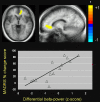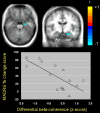Anterior cingulate desynchronization and functional connectivity with the amygdala during a working memory task predict rapid antidepressant response to ketamine
- PMID: 20393460
- PMCID: PMC2869391
- DOI: 10.1038/npp.2010.24
Anterior cingulate desynchronization and functional connectivity with the amygdala during a working memory task predict rapid antidepressant response to ketamine
Abstract
Pregenual anterior cingulate cortex (pgACC) hyperactivity differentiates treatment responders from non-responders to various pharmacological antidepressant interventions, including ketamine, an N-methyl-D-aspartate receptor antagonist. Evidence of pgACC hyperactivition during non-emotional working memory tasks in patients with major depressive disorder (MDD) highlights the importance of this region for processing both emotionally salient and cognitive stimuli. However, it is unclear whether pgACC activity might serve as a potential biomarker of antidepressant response during working memory tasks as well, in line with previous research with emotionally arousing tasks. This study tested the hypothesis that during the N-back task, a widely used working memory paradigm, low pretreatment pgACC activity, as well as coherence between the pgACC and the amygdala, would be correlated with the clinical improvement after ketamine. Magnetoencephalography (MEG) recordings were obtained from 15 drug-free patients with MDD during working memory performance 1 to 3 days before receiving a single ketamine infusion. Functional activation patterns were analyzed using advanced MEG source analysis. Source coherence analyses were conducted to quantify the degree of long-range functional connectivity between the pgACC and the amygdala. Patients who showed the least engagement of the pgACC in response to increased working memory load showed the greatest symptomatic improvement within 4 h of ketamine administration (r=0.82, p=0.0002, false discovery rate (FDR) <0.05). Pretreatment functional connectivity between the pgACC and the left amygdala was negatively correlated with antidepressant symptom change (r=-0.73, p=0.0021, FDR <0.05).These data implicate the pgACC and its putative interaction with the amygdala in predicting antidepressant response to ketamine in a working memory task context.
Figures



Comment in
-
Psychiatric stress testing: novel strategy for translational psychopharmacology.Neuropsychopharmacology. 2010 Jun;35(7):1413-4. doi: 10.1038/npp.2010.29. Neuropsychopharmacology. 2010. PMID: 20463680 Free PMC article. No abstract available.
Similar articles
-
Increased anterior cingulate cortical activity in response to fearful faces: a neurophysiological biomarker that predicts rapid antidepressant response to ketamine.Biol Psychiatry. 2009 Feb 15;65(4):289-95. doi: 10.1016/j.biopsych.2008.08.014. Epub 2008 Sep 25. Biol Psychiatry. 2009. PMID: 18822408 Free PMC article.
-
Preliminary differences in resting state MEG functional connectivity pre- and post-ketamine in major depressive disorder.Psychiatry Res Neuroimaging. 2016 Aug 30;254:56-66. doi: 10.1016/j.pscychresns.2016.06.006. Epub 2016 Jun 23. Psychiatry Res Neuroimaging. 2016. PMID: 27362845 Free PMC article.
-
Predicting Antidepressant Effects of Ketamine: the Role of the Pregenual Anterior Cingulate Cortex as a Multimodal Neuroimaging Biomarker.Int J Neuropsychopharmacol. 2022 Dec 12;25(12):1003-1013. doi: 10.1093/ijnp/pyac049. Int J Neuropsychopharmacol. 2022. PMID: 35948274 Free PMC article.
-
Effect of ketamine on task-based functional magnetic resonance imaging findings in major depressive disorder: A mini-review.J Affect Disord. 2025 Feb 1;370:181-189. doi: 10.1016/j.jad.2024.10.118. Epub 2024 Nov 2. J Affect Disord. 2025. PMID: 39489183 Review.
-
Symptomatology and predictors of antidepressant efficacy in extended responders to a single ketamine infusion.J Affect Disord. 2017 Jan 15;208:560-566. doi: 10.1016/j.jad.2016.10.026. Epub 2016 Oct 26. J Affect Disord. 2017. PMID: 27839782 Free PMC article. Review.
Cited by
-
Ketamine as antidepressant? Current state and future perspectives.Curr Neuropharmacol. 2014 Jan;12(1):57-70. doi: 10.2174/1570159X113119990043. Curr Neuropharmacol. 2014. PMID: 24533016 Free PMC article.
-
Veterans with PTSD demonstrate amygdala hyperactivity while viewing threatening faces: A MEG study.Biol Psychol. 2018 Feb;132:228-232. doi: 10.1016/j.biopsycho.2018.01.005. Epub 2018 Jan 5. Biol Psychol. 2018. PMID: 29309826 Free PMC article.
-
Biomarker Development for Brain-Based Disorders: Recent Progress in Psychiatry.J Neurol Psychol. 2013 Nov 1;1(2):7. doi: 10.13188/2332-3469.1000006. J Neurol Psychol. 2013. PMID: 25110721 Free PMC article.
-
Ketamine and pharmacological imaging: use of functional magnetic resonance imaging to evaluate mechanisms of action.Behav Pharmacol. 2017 Dec;28(8):610-622. doi: 10.1097/FBP.0000000000000354. Behav Pharmacol. 2017. PMID: 29049083 Free PMC article. Review.
-
Ketamine administration reduces amygdalo-hippocampal reactivity to emotional stimulation.Hum Brain Mapp. 2016 May;37(5):1941-52. doi: 10.1002/hbm.23148. Epub 2016 Feb 25. Hum Brain Mapp. 2016. PMID: 26915535 Free PMC article.
References
-
- American Psychiatric Association . Diagnostic and Statistical Manual of Mental Disorders IV. American Psychiatric Association: Washington, DC; 1994.
-
- Anand A, Li Y, Wang Y, Wu J, Gao S, Bukhari L, et al. Antidepressant effect on connectivity of the mood-regulating circuit: an FMRI study. Neuropsychopharmacology. 2005;30:1334–1344. - PubMed
-
- Barch DM, Sheline YI, Csernansky JG, Snyder AZ. Working memory and prefrontal cortex dysfunction: specificity to schizophrenia compared with major depression. Biol Psychiatry. 2003;53:376–384. - PubMed
Publication types
MeSH terms
Substances
Grants and funding
LinkOut - more resources
Full Text Sources
Other Literature Sources
Medical

